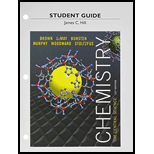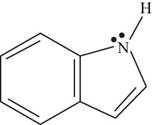
Study Guide for Chemistry: The Central Science
13th Edition
ISBN: 9780321949288
Author: Theodore E. Brown, James C. Hill
Publisher: PEARSON
expand_more
expand_more
format_list_bulleted
Concept explainers
Question
Chapter 9, Problem 89AE
Interpretation Introduction
Interpretation: Indole smells terrible in high concentrations but has a pleasant floral like odor when highly diluted (Figure 1) the molecule is planar, and the nitrogen is a very weak base, with
Concept introduction: Indole is an organic compound, and is hetercyclic, which is found in jasmine. It is also known s benzopyrole and precursor to an amino acid; tryptophan.
To determine: An explanation as to how the given statement corresponding to indole leads to the conclusion that it is an aromatic molecule.

- Figure 1
Expert Solution & Answer
Want to see the full answer?
Check out a sample textbook solution
Students have asked these similar questions
Given a 1,3-dicarbonyl compound, state the (condensed) formula of the compound obtaineda) if I add hydroxylamine (NH2OH) to give an isooxazole.b) if I add thiosemicarbazide (NH2-CO-NH-NH2) to give an isothiazole.
Complete the following acid-base reactions and predict the direction of equilibrium
for each. Justify your prediction by citing pK values for the acid and conjugate acid in
each equilibrium.
(a)
(b) NHs
(c)
O₂N
NH
NH
OH
H₁PO₁
23.34 Show how to convert each starting material into isobutylamine in good yield.
ཅ ནད ཀྱི
(b)
Br
OEt
(c)
(d)
(e)
(f)
H
Chapter 9 Solutions
Study Guide for Chemistry: The Central Science
Ch. 9.2 - Prob. 9.1.1PECh. 9.2 - Prob. 9.1.2PECh. 9.2 - Prob. 9.2.1PECh. 9.2 - Prob. 9.2.2PECh. 9.2 - Prob. 9.3.1PECh. 9.2 - Prob. 9.3.2PECh. 9.3 - Prob. 9.4.1PECh. 9.3 - Prob. 9.4.2PECh. 9.5 - Prob. 9.5.1PECh. 9.5 - Prob. 9.5.2PE
Ch. 9.6 - Prob. 9.6.1PECh. 9.6 - Prob. 9.6.2PECh. 9.6 - Prob. 9.7.1PECh. 9.6 - Prob. 9.7.2PECh. 9.7 - Prob. 9.8.1PECh. 9.7 - Prob. 9.8.2PECh. 9.8 - Prob. 9.9.1PECh. 9.8 - Prob. 9.9.2PECh. 9 - Prob. 1DECh. 9 - Prob. 1ECh. 9 - Prob. 2ECh. 9 - Prob. 3ECh. 9 - Prob. 4ECh. 9 - Prob. 5ECh. 9 - Prob. 6ECh. 9 - Prob. 7ECh. 9 - Prob. 8ECh. 9 - Prob. 9ECh. 9 - Prob. 10ECh. 9 - Prob. 11ECh. 9 - Prob. 12ECh. 9 - Prob. 13ECh. 9 - Prob. 14ECh. 9 - Prob. 15ECh. 9 - Prob. 16ECh. 9 - Prob. 17ECh. 9 - Prob. 18ECh. 9 - Prob. 19ECh. 9 - Prob. 20ECh. 9 - Prob. 21ECh. 9 - Prob. 22ECh. 9 - Prob. 23ECh. 9 - Prob. 24ECh. 9 - Prob. 25ECh. 9 - Prob. 26ECh. 9 - Prob. 27ECh. 9 - Prob. 28ECh. 9 - Prob. 29ECh. 9 - Prob. 30ECh. 9 - Prob. 31ECh. 9 - Prob. 32ECh. 9 - Prob. 33ECh. 9 - Prob. 34ECh. 9 - Prob. 35ECh. 9 - Prob. 36ECh. 9 - Prob. 37ECh. 9 - Prob. 38ECh. 9 - Prob. 39ECh. 9 - Prob. 40ECh. 9 - Prob. 41ECh. 9 - Prob. 42ECh. 9 - Prob. 43ECh. 9 - Describe the intermediate that is thought to form...Ch. 9 - Prob. 45ECh. 9 - Prob. 46ECh. 9 - Prob. 47ECh. 9 - Prob. 48ECh. 9 - (a) Starting with the orbital diagram of a boron...Ch. 9 - Prob. 50ECh. 9 - Prob. 51ECh. 9 - Prob. 52ECh. 9 - Prob. 53ECh. 9 - Prob. 54ECh. 9 - Prob. 55ECh. 9 - Prob. 56ECh. 9 - Prob. 57ECh. 9 - Prob. 58ECh. 9 - Prob. 59ECh. 9 - Prob. 60ECh. 9 - Prob. 61ECh. 9 - Prob. 62ECh. 9 - Prob. 63ECh. 9 - Prob. 64ECh. 9 - In the formate ion, HCO2-, the carbon atom is the...Ch. 9 -
9.66 Consider the Lewis structure shown below....Ch. 9 - Prob. 67ECh. 9 - Prob. 68ECh. 9 - Prob. 69ECh. 9 - Prob. 70ECh. 9 - Prob. 71ECh. 9 - Prob. 72ECh. 9 - Prob. 73ECh. 9 - (a) What is the probability of finding an electron...Ch. 9 - Prob. 75ECh. 9 - Prob. 76ECh. 9 - Prob. 77ECh. 9 - Prob. 78ECh. 9 - Prob. 79ECh. 9 - Prob. 80ECh. 9 - Prob. 81ECh. 9 - Prob. 82ECh. 9 - Prob. 83ECh. 9 - Prob. 84ECh. 9 - Prob. 85AECh. 9 - Prob. 86AECh. 9 - Prob. 87AECh. 9 - Prob. 88AECh. 9 - Prob. 89AECh. 9 - Prob. 90AECh. 9 - Prob. 91AECh. 9 - Prob. 92AECh. 9 - Prob. 93AECh. 9 - Prob. 94AECh. 9 - Prob. 95AECh. 9 - Prob. 96AECh. 9 - Prob. 97AECh. 9 - Prob. 98AECh. 9 - A typical amino acid with one amino group and one...Ch. 9 - The azide ion, N3-, is linear with two N—N bonds...Ch. 9 - Prob. 101AECh. 9 - Prob. 102AECh. 9 - Prob. 103AECh. 9 - Prob. 104AECh. 9 - Prob. 105AECh. 9 - Prob. 106AECh. 9 - How many hydrogen atoms are in 2, 2-...Ch. 9 - Prob. 108AECh. 9 - Prob. 109AECh. 9 - Prob. 110AECh. 9 - Prob. 111AECh. 9 - Prob. 112AECh. 9 - Prob. 113IECh. 9 - Prob. 114IECh. 9 - Prob. 115IECh. 9 - Prob. 116IECh. 9 - Practice Exercise 2 Name the dipeptide and give...Ch. 9 - How many chiral carbon atoms are there in the...Ch. 9 - Prob. 119IECh. 9 - Prob. 120IECh. 9 - Prob. 121IECh. 9 - Prob. 122IE
Knowledge Booster
Learn more about
Need a deep-dive on the concept behind this application? Look no further. Learn more about this topic, chemistry and related others by exploring similar questions and additional content below.Similar questions
- Please help me Please use https://app.molview.com/ to draw this. I tried, but I couldn't figure out how to do it.arrow_forwardPropose a synthesis of 1-butanamine from the following: (a) a chloroalkane of three carbons (b) a chloroalkane of four carbonsarrow_forwardSelect the stronger base from each pair of compounds. (a) H₂CNH₂ or EtzN (b) CI or NH2 NH2 (c) .Q or EtzN (d) or (e) N or (f) H or Harrow_forward
- 4. Provide a clear arrow-pushing mechanism for each of the following reactions. Do not skip proton transfers, do not combine steps, and make sure your arrows are clear enough to be interpreted without ambiguity. a. 2. 1. LDA 3. H3O+ HOarrow_forwardb. H3C CH3 H3O+ ✓ H OHarrow_forward2. Provide reagents/conditions to accomplish the following syntheses. More than one step is required in some cases. a. CH3arrow_forward
- Identify and provide an explanation that distinguishes a qualitative and quantitative chemical analysis. Provide examples.arrow_forwardIdentify and provide an explanation of the operational principles behind a Atomic Absorption Spectrometer (AAS). List the steps involved.arrow_forwardInstructions: Complete the questions in the space provided. Show all your work 1. You are trying to determine the rate law expression for a reaction that you are completing at 25°C. You measure the initial reaction rate and the starting concentrations of the reactions for 4 trials. BrO³¯ (aq) + 5Br¯ (aq) + 6H* (aq) → 3Br₂ (l) + 3H2O (l) Initial rate Trial [BrO3] [H*] [Br] (mol/L) (mol/L) | (mol/L) (mol/L.s) 1 0.10 0.10 0.10 8.0 2 0.20 0.10 0.10 16 3 0.10 0.20 0.10 16 4 0.10 0.10 0.20 32 a. Based on the above data what is the rate law expression? b. Solve for the value of k (make sure to include proper units) 2. The proposed reaction mechanism is as follows: i. ii. BrО¸¯ (aq) + H+ (aq) → HBrO3 (aq) HBrO³ (aq) + H* (aq) → H₂BrO3* (aq) iii. H₂BrO³* (aq) + Br¯ (aq) → Br₂O₂ (aq) + H2O (l) [Fast] [Medium] [Slow] iv. Br₂O₂ (aq) + 4H*(aq) + 4Br(aq) → 3Br₂ (l) + H2O (l) [Fast] Evaluate the validity of this proposed reaction. Justify your answer.arrow_forward
arrow_back_ios
SEE MORE QUESTIONS
arrow_forward_ios
Recommended textbooks for you
 ChemistryChemistryISBN:9781305957404Author:Steven S. Zumdahl, Susan A. Zumdahl, Donald J. DeCostePublisher:Cengage Learning
ChemistryChemistryISBN:9781305957404Author:Steven S. Zumdahl, Susan A. Zumdahl, Donald J. DeCostePublisher:Cengage Learning ChemistryChemistryISBN:9781259911156Author:Raymond Chang Dr., Jason Overby ProfessorPublisher:McGraw-Hill Education
ChemistryChemistryISBN:9781259911156Author:Raymond Chang Dr., Jason Overby ProfessorPublisher:McGraw-Hill Education Principles of Instrumental AnalysisChemistryISBN:9781305577213Author:Douglas A. Skoog, F. James Holler, Stanley R. CrouchPublisher:Cengage Learning
Principles of Instrumental AnalysisChemistryISBN:9781305577213Author:Douglas A. Skoog, F. James Holler, Stanley R. CrouchPublisher:Cengage Learning Organic ChemistryChemistryISBN:9780078021558Author:Janice Gorzynski Smith Dr.Publisher:McGraw-Hill Education
Organic ChemistryChemistryISBN:9780078021558Author:Janice Gorzynski Smith Dr.Publisher:McGraw-Hill Education Chemistry: Principles and ReactionsChemistryISBN:9781305079373Author:William L. Masterton, Cecile N. HurleyPublisher:Cengage Learning
Chemistry: Principles and ReactionsChemistryISBN:9781305079373Author:William L. Masterton, Cecile N. HurleyPublisher:Cengage Learning Elementary Principles of Chemical Processes, Bind...ChemistryISBN:9781118431221Author:Richard M. Felder, Ronald W. Rousseau, Lisa G. BullardPublisher:WILEY
Elementary Principles of Chemical Processes, Bind...ChemistryISBN:9781118431221Author:Richard M. Felder, Ronald W. Rousseau, Lisa G. BullardPublisher:WILEY

Chemistry
Chemistry
ISBN:9781305957404
Author:Steven S. Zumdahl, Susan A. Zumdahl, Donald J. DeCoste
Publisher:Cengage Learning

Chemistry
Chemistry
ISBN:9781259911156
Author:Raymond Chang Dr., Jason Overby Professor
Publisher:McGraw-Hill Education

Principles of Instrumental Analysis
Chemistry
ISBN:9781305577213
Author:Douglas A. Skoog, F. James Holler, Stanley R. Crouch
Publisher:Cengage Learning

Organic Chemistry
Chemistry
ISBN:9780078021558
Author:Janice Gorzynski Smith Dr.
Publisher:McGraw-Hill Education

Chemistry: Principles and Reactions
Chemistry
ISBN:9781305079373
Author:William L. Masterton, Cecile N. Hurley
Publisher:Cengage Learning

Elementary Principles of Chemical Processes, Bind...
Chemistry
ISBN:9781118431221
Author:Richard M. Felder, Ronald W. Rousseau, Lisa G. Bullard
Publisher:WILEY